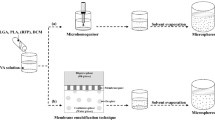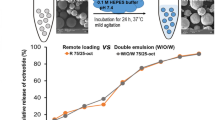Abstract
Here, we examined the effect of melting point of drug carriers on drug release of dexamethasone (Dex)-loaded microspheres. We prepared poly(L-lactide-ran-ε-caprolactone) (PLC) copolymers with varying compositions of poly(ε-caprolactone) (PCL) and poly(L-lactide) (PLLA). As the PLLA content increased, the melting points of PLC copolymers decreased from 61 to 43 °C. PLC copolymers in vials solubilized at 40–50 °C according to the incorporation of PLLA into the PCL segment. Dexamethasone (Dex)-loaded PLC (MCxLy) microspheres were prepared by the oil-in-water (O/W) solvent evaporation/extraction method. The preparation yields were above 70%, and the mean particle size ranged from 30 to 90 μm. The MCxLy microspheres also showed controllable melting points in the range of 40–60 °C. Dex-loaded MCxLy microspheres showed similar in vitro and in vivo sustained release patterns after the initial burst of Dex. The in vitro and in vivo order of the Dex release was MC80L20 > MC90L10 > MC95L5, which agreed well with the melting point order of the drug carrier. Using in vivo fluorescence imaging of fluorescein (FI)-loaded microspheres implanted in animals, we confirmed the sustained release of FI over an extended period. In vivo inflammation associated with the PLC microsphere implants was less pronounced than that associated with Poly(lactide-co-glycolide) (PLGA). In conclusion, we successfully demonstrated that it is possible to control Dex release using Dex-loaded MCxLy microspheres with different melting points.








Similar content being viewed by others

References
Andhariya JV, Burgess DJ. Recent advances in testing of microsphere drug delivery systems. Expert Opin Drug Deliv. 2016;13:593–608.
Ramazani F, Chen W, van Nostrum CF, Storm G, Kiessling F, Lammers T, et al. Strategies for encapsulation of small hydrophilic and amphiphilic drugs in PLGA microspheres: state-of-the-art and challenges. Int J Pharm. 2016;29:358–67.
Sellers DL, Kim TH, Mount CW, Pun SH, Horner PJ. Poly(lactic-co-glycolic) acid microspheres encapsulated in Pluronic F-127 prolong hirudin delivery and improve functional recovery from a demyelination lesion. Biomaterials. 2014;35:8895–902.
Song W, Liu G, Li J, Luo Y. Bone morphogenetic protein-2 sustained delivery by hydrogels with microspheres repairs rabbit mandibular defects. Tissue Eng Regen Med. 2016;13:750–61.
Tomic I, Vidis-Millward A, Mueller-Zsigmondy M, Cardot JM. Setting accelerated dissolution test for PLGA microspheres containing peptide, investigation of critical parameters affecting drug release rate and mechanism. Int J Pharm. 2016;30:42–51.
Ko Y, Park JH, Lee JB, Oh HH, Park WH, Cho D, et al. Growth behavior of endothelial cells according to electrospun poly(D, L-Lactic-Co-Glycolic Acid) fiber diameter as a tissue engineering scaffold. Tissue Eng Regen Med. 2016;13:343–51.
de Alteriis R, Vecchione R, Attanasio C, De Gregorio M, Porzio M, Battista E, et al. A method to tune the shape of protein-encapsulated polymeric microspheres. Sci Rep. 2015;30:12634.
Bae YJ, Cho CH, Lee WJ, Huh JS, Lim JO. Optimization of recombinant human platelet-derived growth factor-BB encapsulated in Poly (Lactic-co-Glycolic Acid) microspheres for applications in wound healing. Tissue Eng Regen Med. 2016;13:13–20.
Park JS, Park KH. Light enhanced bone regeneration in an athymic nude mouse implanted with mesenchymal stem cells embedded in PLGA microspheres. Biomater Res. 2016;20:4.
Shen J, Lee K, Choi S, Qu W, Wang Y, Burgess DJ. A reproducible accelerated in vitro release testing method for PLGA microspheres. Int J Pharm. 2016;498:274–82.
Ma G. Microencapsulation of protein drugs for drug delivery: strategy, preparation, and applications. J Control Release. 2014;10-324-340.
Crotts G, Park TG. Protein delivery from poly(lactic-co-glycolic acid) biodegradable microspheres: release kinetics and stability issues. J Microencapsul. 1988;15:699–713.
Rawat A, Burgess DJ. Effect of physical ageing on the performance of dexamethasone loaded PLGA microspheres. Int J Pharm. 2011;415:164–8.
Allison SD. Effect of structural relaxation on the preparation and drug release behavior of poly(lactic-co-glycolic)acid microparticle drug delivery systems. J Pharm Sci. 2008;97:2022–35.
Liu J, Rigsbee DR, Stotz C, Pikal MJ. Dynamics of pharmaceutical amorphous solids: the study of enthalpy relaxation by isothermal microcalorimetry. J Pharm Sci. 2002;91:1853–62.
Hia IL, Vahedi V, Pasbakhsh P. Self-healing polymer composites: prospects, challenges, and applications. Polym Rev. 2016;56:225–61.
Pereira H, Correlo VM, Silva-Correia J, Oliveira JM, Reis RL, Espregueira-Mendes J. Migration of “bioabsorbable” screws in ACL repair. how much do we know? A systematic review. Knee Surg Sports Traumatol Arthrosc. 2013;21:986–94.
Rachmawati R, Woortman AJ, Kumar K, Loos K. Inclusion complexes between polytetrahydrofuran-b-amylose block copolymers and polytetrahydrofuran chains. Macromol Biosci. 2015;15:812–28.
Park JH, Kang HJ, Kwon DY, Lee BK, Lee BL, Jang JW, et al. Biodegradable poly(lactide-co-glycolide-co-ε-caprolactone) block copolymers—evaluation as drug carriers for a localized and sustained delivery system. J Mater Chem B. 2015;3:8143–53.
Lee JW, Lee HY, Park SH, Park JH, Kim JH, Min BH, et al. Preparation and evaluation of dexamethasone-loaded electrospun nanofiber sheets as a sustained drug delivery system. Materials (Basel). 2016;9:E175.
Kwon DY, Kwon JS, Park SH, Park JH, Jang SH, Yin XY, et al. A computer-designed scaffold for bone regeneration within cranial defect using human dental pulp stem cells. Sci Rep. 2015;5:12721.
Kwon DY, Tai GZ, Park JH, Lee BK, Lee JH, Kim JH, et al. Preparation of methoxy poly(ethyleneglycol)-b-poly(ε-caprolactone-co-L-lactide) and characterization as biodegradable micelles. J Polym Res. 2014;21:474.
Kim JI, Kim DY, Kwon DY, Kang HJ, Kim JH, Min BH, et al. An injectable biodegradable temperature-responsive gel with an adjustable persistence window. Biomaterials. 2012;33:2823–34.
Kang YM, Lee SH, Lee JY, Son JS, Kim BS, Lee B, et al. A biodegradable, injectable, gel system based on MPEG-b-(PCL-ran-PLLA) diblock copolymers with an adjustable therapeutic window. Biomaterials. 2010;31:2453–60.
Park JH, Lee BK, Park SH, Kim MG, Lee JW, Lee HY, et al. Preparation of biodegradable and elastic poly(ε-caprolactone-co-lactide) copolymers and evaluation as a localized and sustained drug delivery carrier. Int J Mol Sci. 2017;18:E671.
Kim BS, Oh JM, Hyun H, Kim KS, Lee SH, Kim YH, et al. Insulin-loaded microcapsules for in vivo delivery. Mol Pharm. 2009;6:353–65.
Kim BS, Oh JM, Seo KS, Cho JS, Kim KS, Lee B, et al. BSA-FITC-loaded microcapsules for in vivo delivery. Biomaterials. 2009;30:902–9.
Acknowledgements
This study was supported by a grant from a Basic Science Research Program (2016R1A2B3007448) through the National Research Foundation of Korea (NRF) funded by the Ministry of Education.
Author information
Authors and Affiliations
Corresponding author
Ethics declarations
Conflict of interest
The authors declare that they have no conflict of interest.
Ethical statement
This study was conducted under the approval of the Institutional Animal Experiment Committee at Ajou University School of Medicine (Approval No. 2016-0048).
Rights and permissions
About this article
Cite this article
Park, J.H., Kwon, D.Y., Heo, J.Y. et al. Effect of Drug Carrier Melting Points on Drug Release of Dexamethasone-Loaded Microspheres. Tissue Eng Regen Med 14, 743–753 (2017). https://doi.org/10.1007/s13770-017-0077-7
Received:
Revised:
Accepted:
Published:
Issue Date:
DOI: https://doi.org/10.1007/s13770-017-0077-7



